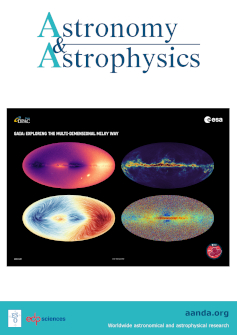利用自组织地图导航AGN可变性
IF 5.4
2区 物理与天体物理
Q1 ASTRONOMY & ASTROPHYSICS
引用次数: 0
摘要
上下文。活动星系核(agn)的分类是天体物理学中的一个挑战。从光曲线中提取的变异性特征为区分agn及其子类提供了一种很有前途的途径。这种方法在Vera C. Rubin天文台遗留空间和时间调查(LSST)的视野中是非常有价值的。我们的目标是利用自组织映射(SOMs)基于可变性特征对agn进行分类,并研究不同特征子集的使用如何影响最终分类的纯度和完整性。我们从光曲线中得出了一组变异性特征,类似于以前的研究中使用的特征,并应用SOMs来探索agn亚类的分布。我们对不同特征子集获得的分类进行了比较分析,重点关注识别不同agn类型的能力。我们的分析表明,使用具有可变性特征的SOMs可以产生相对纯净的agn样品,尽管完整性仍然是一个挑战。特别是,2型agn是最难识别的,这是可以预料的。这些结果代表了一个有希望的一步,朝着开发工具,可能支持agn选择在未来的大规模调查,如LSST。本文章由计算机程序翻译,如有差异,请以英文原文为准。
Navigating AGN variability with self-organizing maps
Context. The classification of active galactic nuclei (AGNs) is a challenge in astrophysics. Variability features extracted from light curves offer a promising avenue for distinguishing AGNs and their subclasses. This approach would be very valuable in sight of the Vera C. Rubin Observatory Legacy Survey of Space and Time (LSST).Aims. Our goal is to utilize self-organizing maps (SOMs) to classify AGNs based on variability features and investigate how the use of different subsets of features impacts the purity and completeness of the resulting classifications.Methods. We derived a set of variability features from light curves, similar to those employed in previous studies, and applied SOMs to explore the distribution of AGNs subclasses. We conducted a comparative analysis of the classifications obtained with different subsets of features, focusing on the ability to identify different AGNs types.Results. Our analysis demonstrates that using SOMs with variability features yields a relatively pure AGNs sample, though completeness remains a challenge. In particular, Type 2 AGNs are the hardest to identify, as can be expected. These results represent a promising step toward the development of tools that may support AGNs selection in future large-scale surveys such as LSST.
求助全文
通过发布文献求助,成功后即可免费获取论文全文。
去求助
来源期刊

Astronomy & Astrophysics
地学天文-天文与天体物理
CiteScore
10.20
自引率
27.70%
发文量
2105
审稿时长
1-2 weeks
期刊介绍:
Astronomy & Astrophysics is an international Journal that publishes papers on all aspects of astronomy and astrophysics (theoretical, observational, and instrumental) independently of the techniques used to obtain the results.
 求助内容:
求助内容: 应助结果提醒方式:
应助结果提醒方式:


